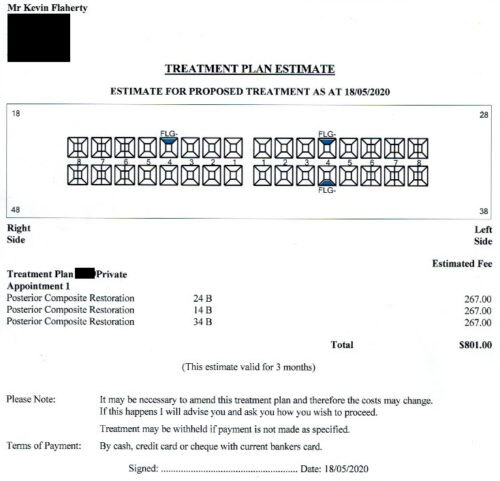Why We Have So Many Problems with Our Teeth
May 29th, 2020Since switching to a mostly paleo diet, I’ve had four cavities, three of which are shown on the quote below. I had none before. *groan*
Maybe the damage was done during the doughnut and pasta days of decades ago??? I don’t know.
Anyway, if you have supported Cryptogon lately, thank you.
Via: Scientific American:
Indeed, the teeth of modern-day humans are a profound contradiction. They are the hardest parts of our body yet are incredibly fragile. Although teeth endure for millions of years in the fossil record, ours cannot seem to last a lifetime in our mouths. Teeth gave our ancestors dominance over the organic world, yet today ours require special daily care to be maintained. The contradiction is new and is limited largely to industrial-age and contemporary populations. It is best explained by a mismatch between today’s diets and those for which our teeth and jaws evolved.


The two best things I’ve found for oral hygiene are brushing the tongue and Closys toothpaste, which can be ordered online by clicking on the Amazon link at the top of the Cryptogon homepage.
The active ingredient for Closys is chlorine dioxide. Not a good idea to swallow it, but it sure keeps my teeth clean. A little dabbed on floss can be very effective too.
My Aussie dentist, a bit of a guru in his profession, reckoned NZers tended to have better jaw development than Australians, and he attributed this mostly to more hard-to-chew foods in their childhood.
Well, it’s possible that whatever diet you had when you were young and still growing also factors into the state of your teeth throughout your lifetime.
Interesting article–the remineralization of the enamel by the saliva and having many more good microbes than bad is the trick. Not in the article but from what I understand, mild or moderate caries can stop progressing and “heal” with the right change of conditions. Steve Solomon who has written many gardening books and now lives in Tasmania, wrote about how much trouble he had with his teeth in the early days when he was raising most of his own food on worn out, unbalanced soil in the foothills of the Willamette Valley, Oregon.
Intriguing recommendation for oral hygiene Dennis—the Closys website states basically that bad bacteria are killed, but good bacteria are spared. It would be interesting to know how well that tracks with this statement in the article:
“To understand why the teeth of modern-day humans are so prone to decay, we need to consider the natural oral environment. The healthy mouth is teeming with life, populated by billions of microbes representing up to 700 different species of bacteria alone. Most are beneficial. They fight disease, help with digestion and regulate various bodily functions.”
Was thinking they might mention Weston A Price DDS in the article, but didn’t. He published a monumental book in 1939—Nutrition and Physical Degeneration—based on many years traveling the World studying the teeth and facial bone development of various cultures, and how those two things relate to overall health. He and others found the Maori of New Zealand to be the most physically perfect humans. Traditional Maori culture placed great importance on food from the sea—fish, shellfish, kelp etc.
Ran across this chlorine dioxide trial for Covid—wondering if it was what Trump’s disinfectant comment was about:
https://clinicaltrials.gov/ct2/show/NCT04343742
Interesting, that the trial began on April Fools day.
Trump was mocked for the disinfectant comment, but also for including the possibility of a light therapy for Covid—but of course light is therapeutic in innumerable ways including inactivating viruses and microbes:
https://www.ncbi.nlm.nih.gov/pmc/articles/PMC7194064/
It is also being studied for internal use in the lungs/intestines:
https://aytubio.com/healight/
@Loveandlight
Apparently the development of our jaws is influenced primarily by chewing. Better jaw development when growing > more space as an adult > fewer occlusion related problems. I’m a fan of Weston Price’s dietary advice, but…
http://claimingpower.com/jaw-development/
@NH
Interesting what you said about chlorine dioxide possibly being what DJT was referring to.
Yes, I was initially concerned about killing off my good bacteria. I know L. salivarius works against decay-causing bacteria and had taken it as a probiotic:
https://humarian.com/l-salivarius/
However, since I started using Closys over a decade ago I don’t get ‘furry’ teeth due to plaque build-up, something that used to be a daily occurrence. This result and others have been a big plus for me. Also, the antibacterial effect may have added health benefits. For example, S. mutans is known to be associated with cardiovascular disease:
https://en.wikipedia.org/wiki/Streptococcus_mutans#Cardiovascular_disease
There are a number of other problematic oral bacteria and lots of studies show an association between their role in gum disease and other internal diseases, e.g. pancreatic cancer, and though there is some debate about ‘chickens and eggs’, it is widely accepted that the they gain access via the mouth, i.e. through gum disease.
One (bad?) thing I noticed after starting on Closys was an increased sensitivity to other people’s bad breath smells. My best guess is this was due to my nose becoming sensitive to those smells because it ceased being regularly exposed to them as ‘background noise’.
Very interesting–thanks for the links. From the Claiming Power website, where it talks about the importance of breast feeding/vigorous chewing and the mechanics of swallowing in the development of good dental arches–definitely.
There’s also a statement in the article about Price’s butter oil/cod liver oil with its “factor x” not being available to or used by indigenous tribes of today, yet they still have good dental arches/facial structure so that Price was at least somewhat on the wrong track.
A few years back I became convinced that the “factor x” that Price talks about is vitamin K2. It’s a complex subject, with there being many forms of vitamin K2 from a wide range of sources, but just as a statement, most hunter gatherers are probably well supplied with it.
Vitamin K2 is associated with vitamin K1, but has a primary influence with vitamin D in regulating where and how calcium is used in the body. From the comment section of the last link, the form of K2 metabolized by animals, may be superior to that produced by fermentation. That said, high levels of micronutrients from food grown in balanced healthy soils has also got to be important in optimal growth and development.
Dr Kate Rheaume-Bleue:
https://www.youtube.com/watch?v=auZCWICR4Ds
https://www.youtube.com/watch?v=Vbd8FqnVT4c
Dr Chris Masterjohn:
https://www.youtube.com/watch?v=-_2prVhp5cU
https://www.westonaprice.org/health-topics/abcs-of-nutrition/on-the-trail-of-the-elusive-x-factor-a-sixty-two-year-old-mystery-finally-solved/
https://chrismasterjohnphd.com/blog/2016/12/09/the-ultimate-vitamin-k2-resource
Dr Leon Schurgers:
https://articles.mercola.com/sites/articles/archive/2015/01/11/vitamin-k1-k2.aspx?e_cid=20150122Z1_WNL_WKLYA_art_1&utm_source=wklynl&utm_medium=email&utm_content=art1&utm_campaign=20150122Z1_WKLYA&et_cid=DM65593&et_rid=814125270
Dr Stephan Guyenet:
http://wholehealthsource.blogspot.com/2008/11/cardiovascular-disease-and-vitamin-k2.html
@NH
Thanks for the links. I will look into them. And thanks for the reminder; there was a time when I used to (make myself!) eat natto for its K2.